Coaxial Cables Guide - Here’s What You Need To Know
What is Coaxial Cable?
Coaxial cables serve as electrical transmission lines. They effortlessly carry high radio frequency (RF) signals from one point to another with low signal loss.
Coax cables have a wide range of applications, including phone lines, cable TV, internet, cell boosters, and more. They come in many sizes and lengths, each designed for specific uses.
We fix poor cell phone signal! Find the right signal booster for you:




In this blog:
- What Does A Coaxial Cable Look Like?
- How Does Coaxial Cable Work?
- What is Coaxial Cable Used For?
- Coaxial Cable Types
- How to Identify Coaxial Cable Types?
- Watch Out for Coaxial Cable Signal Loss (Per 10 Feet)
- Important Coaxial Cable Features to Consider Before You Buy
- Putting It Together
- Coaxial Cable Advantages and Disadvantages
- How Do I Choose Coaxial Cable?
- Coaxial Cable FAQ
What Does A Coaxial Cable Look Like?
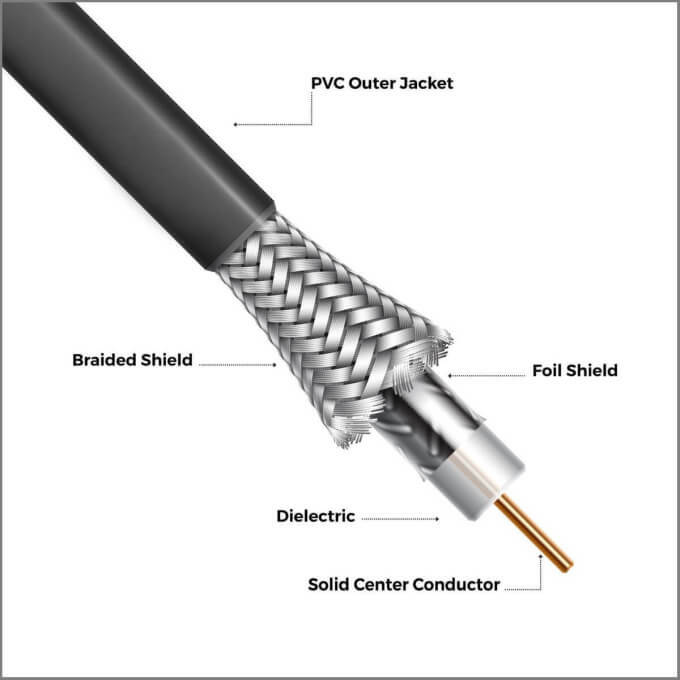
There are four main parts to a coax cable:
- Center Conductor/Core: Usually a single copper or copper-coated steel wire responsible for carrying the RF signals.
- Dielectric Insulator: Surrounds the core and keeps a consistent distance between the center conductor and the next layer. It's often made of plastic.
- Braided Shield: Wraps around the insulator. It's usually made of woven copper, aluminum, or other metals. Its role is to cancel out external electromagnetic interference. Some coaxial cables feature multiple layers of shielding for enhanced protection.
- Jacket (Rubber Wrapper): Encapsulates and shields all components. Its rating (more on this later) indicates where the cable can be installed.
How Does Coaxial Cable Work?
Coaxial cables transmit signals through the center wire. To ensure a quality signal travels the length of the cable a metal shield is needed. Both components receive a current simultaneously, generating a magnetic field. This allows the signal to remain intact and not bleed out like it would without the shield.
The metal shield also helps protect the signal from electromagnetic interference. Thus, coax can be placed near other electronic equipment without any issues.
For optimal performance, the distance between the core and shield must be consistent throughout. The dielectric insulator makes that happen. It also prevents the two signals from coming in contact and canceling each other.
All components are further insulated and protected from damage by the outer jacket.
As a result, RF signals can be carried over long distances with little interference or loss. Depending on your application, the signal is then converted into images, audio, WiFi, or amplified cell reception.
What is Coaxial Cable Used For?

Coaxial cable is used by cable operators, telephone companies, and internet providers. They’re necessary for applications requiring radio frequency transmissions, such as:
Cable TV
If you have cable TV, coax cables carry video and data from the cable company to your TV. They’re also used to connect your television or digital converter box to a personal antenna.
Signal Boosters
Cellular signal boosters use an outdoor antenna, an amplifier, and an indoor antenna to boost cellular signal and deliver it even stronger inside your home, office, or vehicle. Coaxial cables are used to connect the three components. They help bypasses signal blocking material.
Wilson Amplifiers is the leading provider of these devices. Check out our guide on how a signal booster works for more information.
Cable Internet (Copper-Based)
Cable internet uses coax cable to provide your home with internet. The copper-based cable is piped into your house from the cable service provider. Your router or cable modem connects to a coax or ethernet outlet to receive the signal. You can then wire your devices to the router or connect via WiFi for speedy internet access.
Ham Radio
Ham radio is a means for people to communicate over airwaves. Coaxial cable connected to the antenna provides a stronger signal. Ham radios can be set up in the middle of nowhere and do not require internet or cell phone technology.
Basic RF Systems
RF (Radio Frequency) waves are generated when an alternating current goes through a conductive material. Coax cables carry radio frequency signals. They can be used with any RF system.
Coaxial Cable Types
There are many different types of cables to choose from. They fall within two categories, RG and LMR type. Your application will determine which is the best coaxial cable to use. Here are the most common coax cable types:
RG Coax Cables
RG, short for Radio Guide, is the original military specification for coaxial cables. The RG number refers to the cable's diameter. However, measurements do vary. Generally, a higher RG numbers means a thinner central conductor, and vice versa.
RG-6/U is a common type of coaxial cable. It has an impedance of 75 Ohm. It's used in a wide variety of residential and commercial applications, including cable television, home internet, and more.
RG-8 is similar to RG-6, but unable to carry pure video signals. It has an impedance of 50 Ohm. It's used in audio control rooms, radio stations, and external radio antennas.
RG-11 is a higher gauge cable used for CATV, HDTV, TV antennas, and video distribution. It has an impedance of 75 Ohm and covers up to 3 GHz.
RG-59 is a 75 Ohm coax cable best used for CCTV, audio video, and other low-frequency applications. They are flexible and easy to install. Though, they are not meant for long runs.
LMR® Coax Cable
LMR® is the newer generation of RF coaxial cables. They provide greater flexibility, ease of installation, and lower cost. They're used as transmission lines for antennas on missiles, airplanes, satellites, and communications. The LMR ® number is a rough estimate of the cables thickness.
LMR®200 is an outdoor-rated flexible low loss communications coax. It has a 50 Ohm impedance and is great for short antenna feeder runs. This cable also features low-PIM.
LMR®240 is also an outdoor rated flexible low loss communications coax with an impedance of 50 Ohm. It's designed for short feeder runs for applications like GPS, WLAN, and mobile antennas.
LMR®400 is a flexible communications coax with an impedance of 50 Ohm. It's used for jumper assemblies in wireless communications systems and antenna feeder runs. If you need a cable that requires periodic or repeated flexing, choose this one. LMR®400 was designed to replace the RG-8 cables.
LMR®600 or “Half-Inch” is designed for outdoor use as well. It's more flexible than air-dielectric and hardline cables in terms of bending and handling. It also has an impedance of 50 Ohm.
LMR®900/1200/1700 are larger cables. They're designed for medium antenna feeder runs with any application needing an easily routed, flexible low loss cable.
How to Identify Coaxial Cable Types?
The numbers and letters printed on the cable jacket tell you everything you need to know. The type of cable it is, who manufactured it, rating, and more.
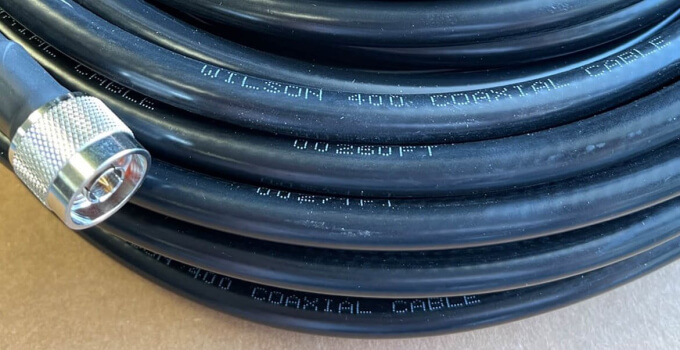
Watch Out for Coaxial Cable Signal Loss (Per 10 Feet)
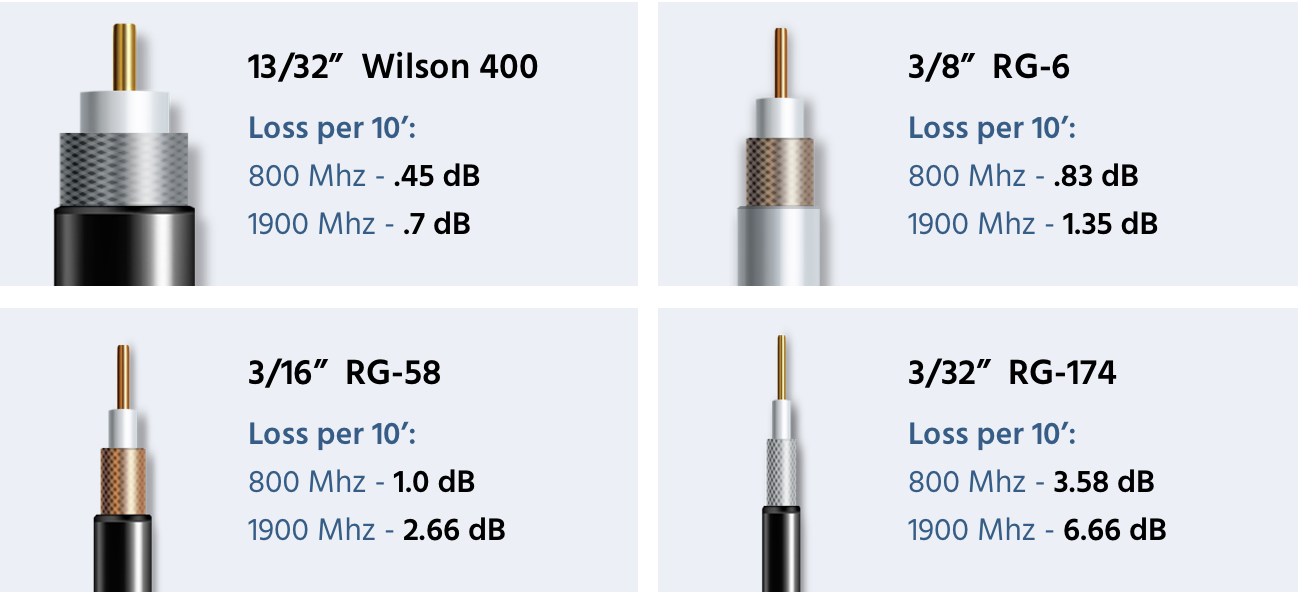
Signal loss happens with all types of coaxial cable. As signal travels through the cable, it loses energy. It’s inevitable. With increased cable length more signal loss occurs.
Signal gain and loss are measured in decibels (dB), which are measured exponentially. A loss of 3 dB means a weakened signal by 2x!
Per the image, the Wilson400 (and the equally powerful RG-11) has the least loss per 10ft. It’s almost twice as effective compared to the RG-6 for home installations. The only mightier cable is the pricey LG600 and even pricier Half-Inch.
The RG-174 should never be installed in any unit that needs more than 6 feet of cable. It does a poor job of carrying signal at 10 feet.
Signal loss doesn’t end there. Mixing and matching 50 Ohm and 75 Ohm cables and systems (more on this later) can lead to further signal loss. While you can customize your installation with connectors and adapters, it's best to stay consistent.
To calculate the amount of loss you should expect, you can use an online calculator. For example, the QSL Loss Calculator. We don’t endorse this one specifically. Simply fill in the blanks and loss will be calculated in seconds.
There are many online calculators you can use as well as formulas for manual calculation.
Important Coaxial Cable Features to Consider Before You Buy

Coaxial Cable Length and Thickness
Coaxial cable comes in varying lengths and thicknesses. These features will determine the strength of the signal transmitted.
As mentioned, the longer the cable the more loss occurs when transmitting signal across long distances. Thick cable features lower loss than thin cable, making it ideal for long cable runs. For optimal transmission, you’ll want the shortest and thickest cable appropriate for your application.
In radio systems, cable length is comparable to the wavelength of the signals transmitted. You can study the math involved in deciding the best cable length to use. Characteristics of the cable, such as outside diameter of the inner conductor, inside diameter of the shield, dielectric contact of the insulator, and magnetic permeability of the insulator, all affect the quality of the wavelength going through your cable.
Coaxial Cable and dBm
dBm represents your signal strength. The type of coaxial cable used will determine how strong a signal your cable can handle.
Coaxial Cable Impedance (Ohms)
Impedance is the amount of resistance waves moving through the coaxial cable encounters. The lower the impedance, the easier the waves flow through the cable. Each type of cable has an impedance rating. Factors affecting this are the size and materials of the cable.
Standard coax impedances are 50 and 75 Ohms. When tested, these impedance ratings were deemed a great balance between power handling and low loss.
What is the difference between 50 and 75 Ohm cables? This analogy might help. Think of signal as a drink and cables as straws. 75 Ohm cables are your typical soda straws, and 50 Ohm cables are jumbo straws.
While 50 Ohm cables transmit signal better, it doesn't mean you need 50 Ohm cable.
50 Ohm cables tend to be better for high power handling applications. These could be commercial boosters, broadcasting TV transmitters, and ham radios. 75 Ohm cables are the popular choice for home and office applications. They're used for residential signal booster installations, cable TV boxes, internet routers, and the like. These are general rules and do not apply to all types of cable.
When choosing cable, avoid mixing and matching 50 Ohm and 75 Ohm cables and systems. You should aim to use the same impedance throughout to prevent additional signal loss.
Coaxial Cable and PIM
PIM stands for Passive Intermodulation. When you connect two metals, the result is nonlinear elements, and distortion in the signal may occur.
As signal amplitude goes up, the effects will be more significant. This often happens when connecting antennas, cables, and connectors. PIM problems occur most often in cellular networks. To mitigate PIM issues, consider low-PIM cables, connectors, and adapters.
Coaxial Cable Rating
All coaxial cables are rated for different applications. The rating tells you everything you need to know about where the cable can be SAFELY installed. The most common are:
- Communications Multipurpose Plenum (CMP) Cable: Plenum coax cable is designed to be used in plenum air spaces. The jacket is fire-retardant and low smoke. In the event of a fire, plenum cables release the lowest level of toxic fumes. They are the safest to use in spaces designed for air circulation.
- Communications Multipurpose Riser (CMR) Cable: Riser cable is mainly used to run cable between floors through risers or vertical shafts. The jacket is also fire retardant to prevent fires from spreading between floors. Though, they are not as heavy-duty as plenum cables.
- Communications Multipurpose (CM) Cable: CM cable, sometimes referred to as PVC cable, is the most commonly used cable rating. It’s rated for general-purpose applications, such as connecting a computer to the wall. It’s not as fire-retardant and will release toxic fumes. They are not to be used in riser or plenum spaces.
Coaxial Cable Connectors

Coax cable connectors are on each end of the cable. They are designed to maintain the integrity of the cable as it transmits signal. They are usually plated with high-connectivity metals, such as tarnish-resistant gold or silver. The type of connector you need depends on what you are connecting to.
Coaxial Cable Connector Types:
SMA stands for Subminiature Version A. It's a minimal connector interface for coaxial cable with a screw-type coupling mechanism. It has an impedance of 50 Ohm and is designed for use from DC (0 Hz) to 18 GHz. Applications include microwave systems, handheld radios, and mobile telephone antennas.
SMB stands for Subminiature Version B. SMBs are smaller than SMAs and feature a snap-on coupling design. They are available in 50 and 75 Ohms and operate up to 4 GHz. Less robust than SMA, they can’t be used in harsh environments. Common applications include base stations, antennas, GPS, and computer systems.
F-Type connectors are mid-size connectors designed for common use. They are commonly found on RG-6/U cable. F-Types are the most widely used connector for residential wiring. They're used with cable television, satellite television, and cable modems.
N-Type connectors are larger connectors designed to be used with thick, commercial cable.
FME (For Mobile Equipment) is a 50 Ohm miniature coax connector that offers performance from DC to 2000 MHz. It’s mainly used in cellular communication devices and data applications.
Threaded Neill–Concelman (TNC) connectors are commonly used in mobile phones and RF/antenna connections. They are weatherproof and operate up to 11 GHz.
UHF connector, also known as Amphenol coax connector, is a 50 Ohm connector for low-frequency RF applications. It’s widely used in amateur radio, citizens' band radio, and marine VHF radio. It’s suitable for use up to 300 MHz.
Connectors are either standard or reverse polarized male or female.
Standard polarized male connectors have threads on the inside of the shell and a pin. On the other hand, standard polarized female connectors have threads on the inside of the shell and no pin. The hole and pin are switched in reverse polarized connectors. In other words, the female connector has the pin, and the male connector has the hole.
The only way to connect a male to male or female to female is with a coax cable adapter, which also causes signal loss. Signal attenuation from an adapter will depend on the quality.
Check the plug on your device to avoid unnecessary signal loss. If it’s a standard female, you need a standard male plug and vice versa. Getting a coaxial cable with the correct connector from the get-go is recommended.
Putting It Together
RG-6 Cables with F-Type Connectors
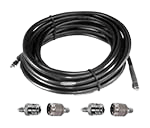
The RG-6 cable is a 75 Ohm cable with F-Type connectors. This is the same cable used with many cable/satellite TV devices. It also comes pre-wired in many homes, making it simple to wire and install.
The F-Type connector is a mid-size connector designed for common use. It is the most widely used coaxial connector for residential wiring.
Mainly used for the average home installation that covers 186 sq m to 465 sq m. Cable length from .6 to 9 meters. Comes in white or black, depending on length.
These come kitted with the popular weBoost Home MultiRoom and the budget weBoost Home Room.
RG-11 Cables with F-Type Connectors
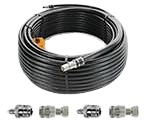
Ultra-low-loss 75 Ohm RG-11 cable for any RF application.
Starting at $25.99The RG-11 cable is another 75 Ohm cable with F-Type connectors. What separates it from the RG-6 is its range. Whereas RG-6 tops out at 15 meters, RG-11 ranges from .6 feet to a 152 meter spool. It also features lower loss.
They are highly recommended if you need over 15 meters of cable to power your booster or any other RF system. RG-11 cable comes pre-kitted with the powerful weBoost Home Complete, weBoost Office 100 75 Ohm, and weBoost Office 200 75 Ohm.
LMR®400 Equivalent Cables with N-Type Connectors
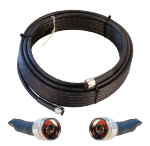
Ultra-low-loss 50 Ohm LMR®400 spec cable for any RF applications.
Starting at $25.99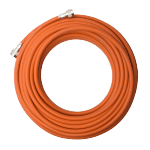
Wilson400 cables are 50-ohm, pro-grade coaxial cables designed for large installations from 697 to 4,645 square meters. Cable length ranges from .6 to 305 meters, spooled.
Your installer will typically apportion the cable into shorter lengths to cover the range of the installation while maintaining quality signal strength.
This Wilson400 is fitted with an N-Type connector, a large connector designed to be used with thick, commercial cable.
If you need to run cable through plenum airspaces, Wilson400 Plenum cable is available. It features ultra-low-loss and comes in a 152 meter spool with no connectors. Cable can be easily terminated to fit any application.
The most popular units that Wilson400 cables are the weBoost for Business and WilsonPro line of commercial signal boosters. However, they are compatible with any equipment that uses 50 Ohm cables fitted with N-Connectors. No unit includes Wilson 400 Plenum.
LMR®600 Equivalent and LDF4/AI4 RPV-50 “Half Inch” with N-Type Connector
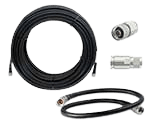
If you need to run cable in excess of 45 meters, your installer may recommend either an LMR®600 or a “half inch” coaxial cable. These are extremely thick cables which are much more industrial than any of the other varieties, and are expensive to boot. An installer will only recommend either of these in rare, specialized situations depending on individual need, but should they do so they will certainly have good cause. These are the best available cables to maintain a quality signal strength on the market.
The difference between an LDF4 and an AI4 RPV-50 is the interior - the LDF4 has a foam covering, and the AI4 RPV-50 has nothing. The difference in function, however, is minimal.
RG-58 and RG-174 Cables with SMA Connectors
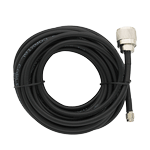
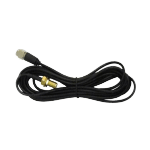
RG58 and RG174 cables are used in vehicle boosters. The difference between the two is the better low-loss quality of the RG58 with cable length up to 6 meters compared to the RG174’s 2 meters. For large vehicles, such as RVs or boats, the RG174 is preferred.
Both are fitted with SMA connectors. These are small, copper connectors used in modems and the like. They are relatively inexpensive, which allow for the cable’s cheaper cost.
Compatible with weBoost Drive Reach, weBoost Drive Sleek, and the weBoost Drive X.
Coaxial Cable Advantages and Disadvantages
Like all electrical equipment, coaxial cable has its advantages and disadvantages.
Advantages:
- Durable
- Good electromagnetic interference resistance
- Affordable
- Easy to customize and expand
- Easy to wire and install
Disadvantages:
- It can be bulky and an eyesore if not hidden
- Expensive to professionally install for long runs
- Cable failure can cause your entire network to go down
- Fragile
How Do I Choose Coaxial Cable?

To choose the best coax cable for your application, there are many things to consider.
What device are you using? A cell booster might require a different cable than a satellite dish. Will the cable be installed inside or outside? Different use cases call for different cable ratings.
Reference different cable types to see which ones will work best with your device. Choose the one that has the impedance, rating, and connectors you need.
Next, calculate the distance between your transmitter and receiver. For example, the distance from an outdoor antenna to a cable box or amplifier. Since shorter cable runs produce crisper signal, your cable should be close to the distance you calculated. Nothing shorter or excessively longer.
Loss of signal is inevitable when traveling across any distance. A shorter cable will have less loss than a longer cable and a thicker cable will have less loss than a thinner cable. Acceptable loss will depend on your devices and your application. To minimize loss, impedances must match across cables and devices.
Remember, if you want to calculate loss, there are various online calculators available.
Coaxial Cable FAQ
Are All Coax Cables the Same?
While all coaxial cables are used to transmit signals, they are not all the same. Coaxial cables vary in size, material, and shielding. Each type of coax cable works best with specific applications. Reference types of coaxial cables for more information.
How Long Should a Coax Cable Be?
For best performance, coaxial cables should be as long as you need them to be. No more, no less. Using more cable than necessary will result in unnecessary signal loss. Using a shorter cable will force you to add extra cable with connectors, which will also cause signal loss.
What is the Transmission Speed of Coaxial Cable?
The speed at which coaxial cables transmit data depends on the type of cable and the technology that gives it its speed. For example, your internet service provider, cable company, and the like. On average, coaxial cable transmission speed ranges from 10 Mbps to upwards of 100 Mbps.
Does Coax Cable Go Bad?
Coaxial cable can last for many years, but it can go bad. The main culprits are:
- Heat damage – When exposed to high temperatures for a prolonged amount of time, the plastic wrap can melt. Unprotected, the inner components will get damaged.
- Physical damage – Bending coax cable or stepping on it can damage the inner components, affecting transmission.
- Water damage – Water inside the cable can affect the electrical components. Depending on severity, it can degrade performance or render the cable useless.
- Connector damage – If a connector comes loose, rusts, or breaks, the cable can't efficiently transmit information from one source to another or at all.
Increasing the longevity of your coaxial cable starts with buying the right cable. From there, make sure to install it correctly, weatherproof the connectors, and avoid bending it.
Can I Install Coaxial Cable Outdoors?
Coaxial cable can be used in both indoor and outdoor applications with a few differences. Coax used outdoors requires additional insulation to protect the wires. Cables rated for outdoor use may run along the outside of your home to an antenna or cable box on the corner. Whether out in the sun or buried in the earth, the cable needs to be protected enough to provide seamless transmissions.
Our coaxial cables are outdoor rated, but not direct burial rated.
Does It Matter What Coaxial Cable I Use?
Yes. A signal booster might need a different cable than radio systems. For best results, it’s important to use a cable that's appropriate for your application.
Manufactures of Coaxial Cable
Bolton Technical is a leading provider of coaxial cables, connectors and antennas used in high-end electronics and equipment.
Wilson Amplifiers is the leading provider of cellular boosters and supporting accessoties, which includes coaxial cables. If you’re looking for high-quality coax cable to stay connected, we can help you. Give us a call at 1-800-373-2927 or email us at sales@wilsonamplifiers.ca and we’ll help you find the bet coaxial cable for your needs.
LMR® is registered trademark of Times Microsystems.
Coaxial Cable Sources


Money Back Guarantee

Technical Support

